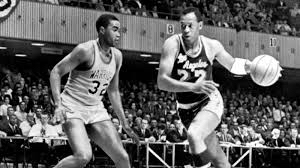The Los Angeles Lakers unveiled a bronze statue of Elgin Baylor at Staples Center before Friday night’s game against the Minnesota Timberwolves.

What took them so long?
The Staples Center has been in existence since 1999; Baylor has been retired since 1971.
Baylor, a Washington, D.C. native, became the sixth Laker to be honored with a statue outside the arena. He joins Magic Johnson, Kareem Abdul-Jabbar, Jerry West, Shaquille O’Neal and longtime play-by-play announcer Chick Hearn.
“He was unique. He helped build basketball here. The Lakers wouldn’t be the Lakers without him,” his longtime teammate Jerry West said in a video tribute shown before the unveiling.
Actually, West didn’t go far enough.
There might not be any Lakers at all if it weren’t for Baylor.
When the franchise drafted Baylor in the spring of 1958, it was still located in Minneapolis – hence the team nickname.
Lakers owner Bob Short – yes, the same Bob Short that moved baseball out of Washington – was in dire financial straits at the time. He already was looking around for another place to locate the team because attendance in Minneapolis was so poor.
To have any chance of succeeding in Minneapolis – or anywhere else – Short needed a star, a drawing card, someone who could put fans in the seats. Short had the first selection in the draft, so he had his pick of college players to choose from.
He set his sights on Baylor, who had just led an unknown Seattle University team to the NCAA finals, where the Chieftains lost to mighty Kentucky.
Baylor was exactly the kind of player Short was looking for. He had averaged more than 30 points per game during his college career and led the nation in rebounding (despite being just 6-foot-5) as a junior.
But more than someone who produced gaudy statistics, he was the kind of player people would pay money to see. His high-flying, improvisational style made him a pioneer as the professional game went airborne.
The way he played created a template for many who followed, including Connie Hawkins, Julius Erving and Michael Jordan, among others.
Short had to have him – almost literally. But he had to be careful in negotiations, because Baylor had some leverage in the bargaining process. He’d started his college career at the tiny College of Idaho, and sat out a year after he transferred to Seattle.Technically, he was eligible to be taken in the ’58 draft. But he also had the option of returning to school for his senior year.
Ultimately, Baylor chose to sign with the Lakers. It’s not too much of a stretch to say that his decision changed (or at least established) the course of NBA history.
In a 1971 interview with the Los Angeles Times Short had said: “If he had turned me down then, I would have been out of business. The club would have gone bankrupt.”
Ponder that for a moment. If the Lakers fold, then they can’t move to Los Angeles. They can’t draft Jerry West, Baylor winds up in some other city (as does West) and he storied Lakers-Celtics rivalry never happens.
Interest in those games and their seemingly inevitable matchup in the NBA Finals (1962,’63, ’65, ’66, ’68 and ‘69) helped keep the league afloat during the 1960s as pro basketball tried to gain equity with more popular sports like pro football and major-league baseball.
Aside from what he contributed to the game and to the league, there was Baylor’s considerable talent on the court. He played 14 seasons with the Lakers – two in Minneapolis and 12 in Los Angeles. Injuries and his ultimate retirement limited him to just 11 games in his last two seasons. Still, he averaged an other-wordly 27.4 points, 13.5 rebounds and 4.3 assists during his career.
He was an 11-time All-Star (All-Star Game MVP in 1958-59, the 1958-59 Rookie of the Year and 10-time All-NBA first-team selection. He was also the first player to score 70 points in a game, getting 71 against the New York Knicks in 1960. (Think for a moment about what that did for the league’s visibility; a guy scoring 71 points at Madison Square Garden!) By the way, Baylor still holds the all-time single-game NBA Finals scoring record with 61 points against Boston in 1962.
Taking all that into consideration, he should have been the first Laker honored with a statue at Staples Center, not the sixth.
Come to think of it, we ought to have a statue of him here in Washington, D.C., too. After all, he’s the greatest player the city has ever produced.
How about it?